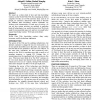787 search results - page 41 / 158 » Using Rough Sets as Tools for Knowledge Discovery |
CHI
2002
ACM
16 years 25 days ago
2002
ACM
We report on a diary study of how and why knowledge workers use the World Wide Web. By examining in detail a complete two-day set of Web activities from each of 24 people, we cons...
106
Voted
BMCBI
2010
15 years 17 days ago
2010
Background: In biological and medical domain, the use of web services made the data and computation functionality accessible in a unified manner, which helped automate the data pi...
175
Voted
APVIS
2011
14 years 14 days ago
2011
Many data sets exist that contain both geospatial and temporal elements. Within such data sets, it can be difficult to determine how the data have changed over spatial and tempor...
107
Voted
BMCBI
2010
15 years 17 days ago
2010
Background: Understanding the genetic basis of disease risk in depth requires an exhaustive knowledge of the types of genetic variation. Very recently, Copy Number Variants (CNVs)...
113
click to vote
ICCS
2004
Springer
15 years 5 months ago
2004
Springer
The Knowledge Agent Mediation Language (KNAML) is designed for use in multi-agent reasoning systems. Like conceptual graphs, KNAML represents knowledge using concepts, relations, a...

